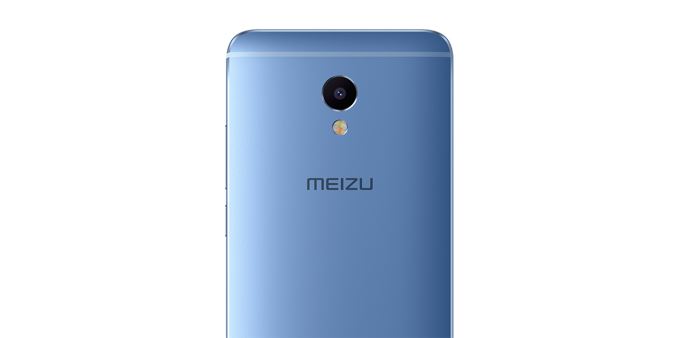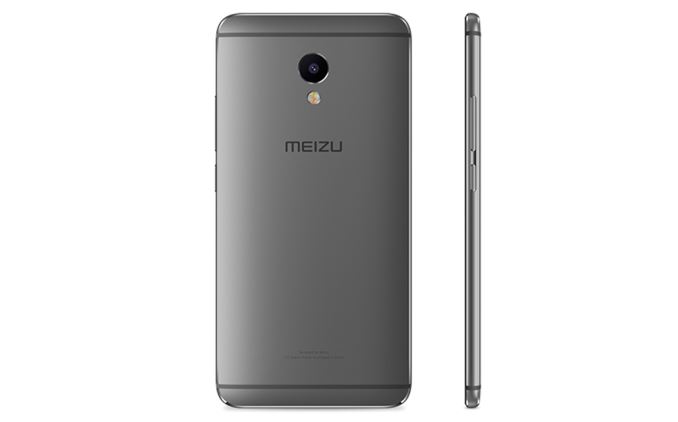Meizu M3E Launched: Helio P10, 5.5-inch Full HD, ¥1299
by Matt Humrick on August 10, 2016 2:45 PM EST- Posted in
- Smartphones
- Mobile
- MediaTek
- Meizu
- Helio P10

Today at a launch event in Beijing, Meizu announced the latest edition to its lower-cost M-series of smartphones. The M3E adheres to Meizu’s established design and construction methods, with an all-aluminum chassis topped with 2.5D edge-to-edge cover glass. The single-piece volume rocker and power button sit within a polished groove that matches the polished, chamfered edges around the sides as well as the recessed rear camera and flash modules. The M3E comes in five colors: silver, gray, blue, gold, and rose gold.
Like Meizu’s M3 note, the M3E comes with a fully laminated, 5.5-inch 1080p IPS LCD display with a peak brightness of 450 nits, according to Meizu. There’s a touch-based, capacitive fingerprint sensor below the screen that also works as a capacitive back button when tapped and a home button when pressed. Swiping up from the lower bezel opens the recent apps menu, which eliminates the need for additional capacitive or onscreen navigation buttons.
| Technical Specifications | ||
| Meizu M3E | Meizu M3 note | |
| SoC | MediaTek Helio P10 (MT6755M) 4x Cortex-A53 @ 1.8GHz 4x Cortex-A53 @ 1.0GHz Mali-T860MP2 |
MediaTek Helio P10 (MT6755M) 4x Cortex-A53 @ 1.8GHz 4x Cortex-A53 @ 1.0GHz Mali-T860MP2 @ 546MHz |
| RAM | 3GB LPDDR3 | 2GB / 3GB LPDDR3 |
| NAND | 32GB (eMMC 5.1) + microSD |
16GB / 32GB (eMMC 5.1) + microSD |
| Display | 5.5-inch 1920x1080 IPS LCD | 5.5-inch 1920x1080 IPS LCD |
| Dimensions | 153.6 x 75.8 x 7.9 mm 172 grams |
153.6 x 75.5 x 8.2 mm 163 grams |
| Modem | MediaTek (Integrated) 2G / 3G / 4G LTE (Category 6) FDD-LTE / TD-LTE / TD-SCDMA / WCDMA / CDMA / GSM |
MediaTek (Integrated) 2G / 3G / 4G LTE (Category 6) FDD-LTE / TD-LTE / TD-SCDMA / WCDMA / CDMA / GSM |
| SIM Size | 2x NanoSIM (dual standby) | 2x NanoSIM (dual standby) |
| Front Camera | 5MP, f/2.0 | 5MP, f/2.0 |
| Rear Camera | 13MP, 1/3.06" Sony IMX258 Exmor RS, 1.12µm pixels, f/2.2, PDAF, HDR, dual-tone LED flash | 13MP, 1/3.06" OmniVision OV13853, 1.12µm pixels, f/2.2, PDAF, HDR, dual-tone LED flash |
| Battery | 3100 mAh non-replaceable |
4100 mAh (15.79 Wh) non-replaceable |
| Connectivity | 802.11b/g/n/ac, BT 4.1 LE, GPS/GNSS, USB Type-C | 802.11b/g/n/ac, BT 4.0 LE, GPS/GNSS, microUSB 2.0 |
| Launch OS | Yun OS 5.1 with Meizu Flyme OS 5 | Android 5.1 with Meizu Flyme OS 5.1 |
| Launch Price (No Contract) |
¥1299 $196 USD |
¥799 / ¥999 $120 / $150 USD |
The table above shows significant overlap between the new M3E and the M3 note. They both use the same MediaTek Helio P10 SoC with four ARM Cortex-A53 CPUs at up to 1.8GHz and another four at up to 1.0GHz in a big.LITTLE arrangement. There’s also an ARM Mali-T860MP2 GPU, which features two ALUs per core instead of three ALUs per core like the high-end Mali-T880.
In our M3 note review, the Helio P10 delivered adequate performance for light workloads, but could not match the speed and user experience of Qualcomm’s Snapdragon 650 SoC in the similarly priced Xiaomi Redmi Note 3. The Helio P10’s low-power GPU is also unsuitable for serious gaming, but is sufficient for playing casual titles.
The M3E comes with 3GB of LPDDR3-1866 RAM and 32GB of eMMC 5.1 NAND, also like the M3 note. Both phones also support microSD cards for storage expansion and 802.11ac Wi-Fi, which is nice to see at this price point, but neither phone includes NFC. The M3E at least ditches microUSB in favor of the newer Type-C port.
MediaTek’s Category 6 LTE modem comes integrated with the Helio P10 SoC, offering up to 300 Mb/s down and 50 Mb/s up with 2x20 MHz carrier aggregation and 64-QAM on the downlink. Both the M3E and M3 note accept dual NanoSIM cards and support Dual SIM Dual Standby (DSDS) operation. Meizu says the M3E supports 18 frequency bands, which is the same number as the mainland China version of the M3 note. Based on the hardware similarities, it’s likely the M3E supports the same frequency bands as the M3 note, which means no support for North American LTE frequencies.
The M3E comes with a 5MP front-facing camera and 13MP rear camera with phase detect autofocus (PDAF); however, the M3E is using a Sony IMX258 image sensor for the rear camera. The M3 note’s camera performed poorly in our testing, so hopefully this change improves image quality.
Overall, the M3E appears to be a minor revision of the M3 note. It’s updated design, USB Type-C port, and new rear camera are offset by a significantly smaller battery. It’s also disappointing to see Meizu stick with the Helio P10 SoC. The Redmi Note 3’s Snapdragon 650, which includes two Cortex-A72 CPUs and an Adreno 510 GPU, provides a substantially better user experience at a similar price.












20 Comments
View All Comments
mortimerr - Thursday, August 11, 2016 - link
Because a lot of everyday browsing and use doesn't require much more than that. The 650 is a solid chip, the battery in the Redmi is huge and at only 1080 is more efficient than something with 1440, and some people don't game at all so why put in a GPU that sucks more power when people don't need it.Sure UFS is faster, but again, the EMMC inside isn't slow. And unless the only reason you have a device is to show it off to people with your read/write speeds, the speeds from the nand will be enough for some people.
The point is, that the performance is not orders of magnitudes less than a device that costs hundreds more.
serendip - Thursday, August 11, 2016 - link
I've gotten 10 hours screen on time on an unmodded kernel, close to what Anandtech got with their testing. That's crazy for a phone this cheap. I'm now testing a bunch of CM13-based ROMs and they're even faster and with longer battery life.If that's not a flagship killer, I don't know what is ;) I don't game so this is the perfect workday pocket computer for me.
fanofanand - Friday, August 12, 2016 - link
A "flagship killer" has always been a phone with comparable specs and performance for a substantially lower price. You don't get to re-define things to suit your own thinking. This is a reasonable alternative for people who don't need the latest and greatest, and that market has become swollen in the last year or so. Don't misunderstand, I'm very pleased with the commoditization of the mobile market, but a "flagship killer" this is not.fanofanand - Thursday, August 11, 2016 - link
EMMC & A53, how 2012 of them.serendip - Friday, August 12, 2016 - link
Not if you're engineering to a budget. Besides, a lot of flagship phones have tech that doesn't amount to a better user experience, just a higher BOM. Sales of these good-enough cheap Android phones are cannibalizing the top end because for most people, they're good enough.Especially the Snapdragon 650. That's a flagship-class chip lurking in bargain basement phones.
fanofanand - Friday, August 12, 2016 - link
The A72 cores in the 650 are what makes it a reasonable alternative to the flagship chipsets. This particular devices uses very slow A53 cores that aren't particularly fast nor power efficient in comparison to newer devices. Yes, it's better than A7 or A9 but this is hardly a modern chipset.BrokenCrayons - Thursday, August 11, 2016 - link
Regarding the statement, "The Helio P10’s low-power GPU is also unsuitable for serious gaming, but is sufficient for playing casual titles," I'm not keeping up well with modern phone hardware so I'm curious about the sorts of games that are currently available for phones. Are they really starting to approach the point where they're suitable as a primary gaming platform? Are we talking about console-like graphics or something more competitive with modern PCs? If there's decent entertainment to be had on higher end phones, maybe it's finally time to exit PC gaming in favor of just using an Android for that kind of entertainment.fanofanand - Friday, August 12, 2016 - link
Mobile games are starting to use the unity engine etc. so the graphics are (IMO) similar to N64 or so. Maybe original Xbox/Playstation. With the latest tech you can stream to your TV and simply use the phone as a controller, and that streaming takes a good bit of GPU power. Solitaire is not going to stress this GPU, but the latest Asphalt etc. certainly will. Some of the newer engines remain playable on Snapdragon 800, but the framerates can be rough at times. Phones are getting to be a lot like tiny desktops, some game some don't. Your needs are dependent on your use case.fanofanand - Friday, August 12, 2016 - link
As for ditching PC for Android gaming, not until they ditch microtransactions. Microtransactions are the bane of mobile gaming. Whereas you used to be able to plop down $50-60 and everyone has the same opportunities, on mobile it's all about Free to Play, Pay to Win. It's a terrible, terrible business model for the consumer, and breathtakingly profitable for the developers. I foresee a revolt against Microtransactions, though not soon enough for my liking.BrokenCrayons - Monday, August 15, 2016 - link
Thanks for the thoughts on Android gaming. I'm not too worried about microtransactions though. They're tolerable and for many games that I've played they only speed up the rate at which you advance in a given game rather than act as a recurring paywall. I suppose that might be different in multiplayer games and newer games, but the Gingerbread-era things I tinkered with weren't too bad about that. Now that local printer support has started coming together, it might be time to start looking at Androids again more seriously.